Goddess Durga information (facts) (avatars) (importance) (significance) (various forms, weapons, etc.)
Namaste friends, how are you doing today? Welcome to #BhagavanBhakthi website / blog.
Bhagavan Lord Sri Krishna (Vishnu) (Rama) blessings to you and your family!
In this website / blog, you will always learn about #Hinduism #Sanskrit language.
Also subscribe to my YouTube channel from this link #BhagavanBhakthi to view videos about #Hinduism #Sanskrit language.
Just before going to “Goddess Durga information (facts) (avatars) (importance) (significance) (various forms, weapons, etc.)“, let us know a brief, basic and very important information.
![]()
We should always remember that, whatever is given in Hindu scriptures has to be followed and never the fictional, mythical, unreal, non-existent, fantasy, etc. type of Gods and Goddesses.
But, we should always be aware of the real facts as given in the Hindu scriptures.
Just for example, when someone is a student and want to buy one or more authentic text books which is as prescribed by a board.
Thus, that student(s) should always get the text books which are prescribed by a board, good teacher (lecturer, professor).
And not someone who is a third party person who knows little or limited knowledge about the values of the text books.
Now, let’s know few real and correct facts about Goddess Durga Devi as prescribed by Hindu scriptures.
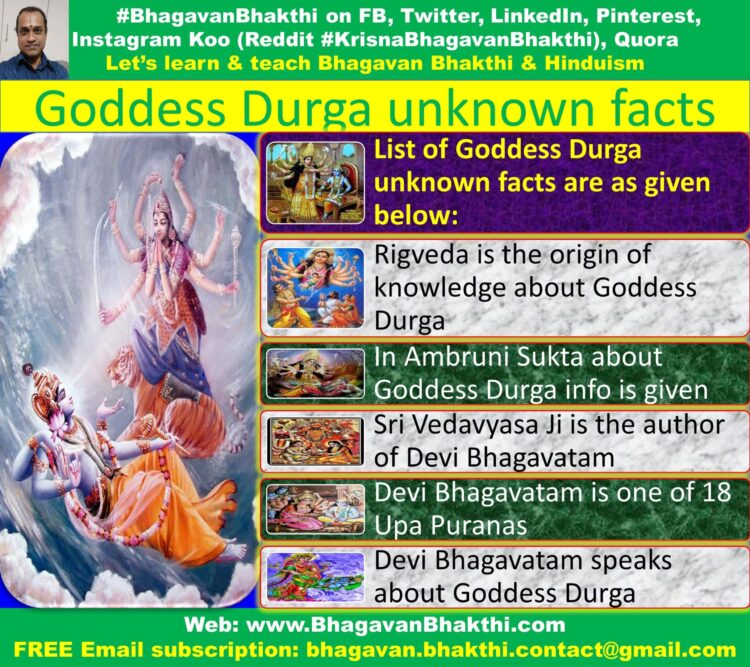
List of Goddess Durga information (facts) is as given below:
Rigveda is the origin of knowledge about Goddess Durga | In Ambruni Sukta about Goddess Durga info is given |
Sri Vedavyasa Ji is the author of Devi Bhagavatam | Devi Bhagavatam is one of 18 Upa Puranas |
Devi Bhagavatam speaks about Goddess Durga | Brahmasutra (2.2.42-45) should be used to negate the imaginary Devis |
Om Shakti or Para Shakti conflicts with Goddess Durga | To about Goddess Durga, knowledge about Vedas, Puranas, Itihasas is a must |
Comparison between popular version vs. real version of Nava Durgas | Who is the real Goddess Durga |
Agnana (ignorance) and Moha (soft spot) should go-away | And many more as given below…
Now, let us move to know more and correct knowledge about Goddess Durga:
Thanks to Hindu Texts who has given us the correct knowledge about the Goddess Durga, by giving verse to verse meaning taking shlokas from Hindu scriptures.
It is very well explained about the real values about the Goddess Durga which can be accepted.
And we can keep away the so called imaginary and fictitious Devis which are completely unacceptable as per Hindu scriptures.
One among the 18 Upa Puranas is Devi Bhagavatam.
As given in ‘Ambruni Sukta’ in Rigveda, praising the “Goddess / Devi” clarifies this as given below:
मम योनिरप्स्वंतः समुद्रे ततो वि तिष्टे भुवनानि विश्वो ||
ಮಮ ಯೋನಿ ರತ್ಸ್ವಂತಃ ಸಮುದ್ರೇ ತತೋ ವಿ ತಿಷ್ಟೆ ಭುವನಾನಿ ವಿಶ್ವೋ ||
mama yōni ratsvantaḥ samudrē tatō vi tiṣṭe bhuvanāni viśvō ||
Meaning of this above shloka : “I (Goddess Lakshmi) create the universe and also all the beings in it. I promote those I like to the post of Chaturmukha Brahma, Rudra.”
“I myself make the highly talented, the Rishis. But, my creator lies in the sea of Pralaya (Lord Vishnu)”.
Goddess Lakshmi says that, she creates the universe and also the beings in it. She adds that, she promotes Devatas like Brahma, Rudra etc.
She herself makes the highly talented people, Rishis etc., but finally she also adds that, she is completely dependent on Lord Vishnu for anything and everything.
This is the real meaning.
From this, we can easily and clearly understand that the highest Devi (Goddess) is Goddess Lakshmi as given in this shloka of Ambruni Sukta.
(Few people pronounce this as Ambrini Sukta which is incorrect).
In addition to above explanation, it is Goddess Lakshmi who does all the creation, maintenance, and dissolution.
But Goddess Sri Lakshmi Devi is completely dependent on Lord Sri Vishnu and she is not at all independent.
Goddess Lakshmi does this all as per the instructions and grace of Lord Vishnu, who makes the original creation, maintenance and dissolution.
Devi Bhagavatam itself, which initiates the idea of Om Shakti or Adi Parashakti provides the clue that,
Lord Vishnu is the supreme in multiple aspects in its very first chapter itself.
But people who read it with dyed eyes will not always oversee it.
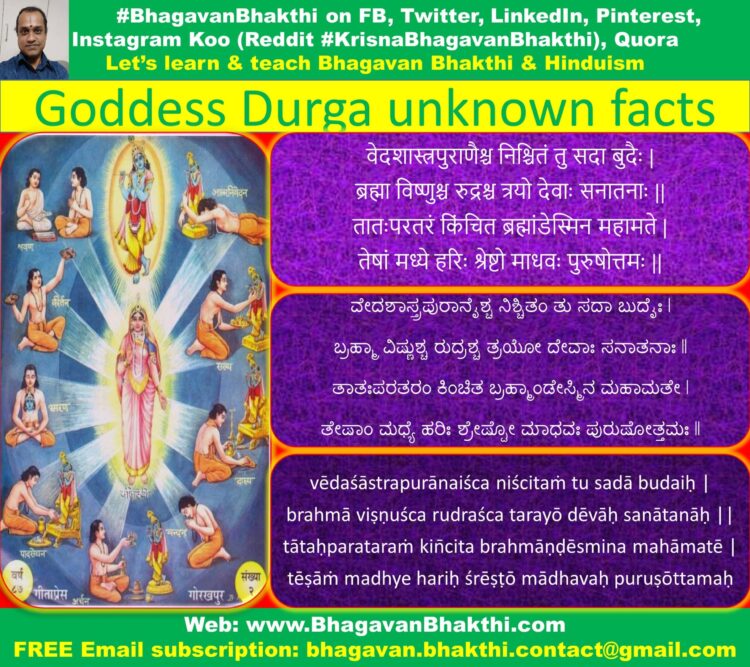
वेदशास्त्रपुराणैश्च निश्चितं तु सदा बुदैः | ब्रह्मा विष्णुश्च रुद्रश्च त्रयो देवाः सनातनाः || तातःपरतरं किंचित ब्रह्मांडेस्मिन महामते | तेषां मध्ये हरिः श्रेष्टो माधवः पुरुषोत्तमः ||
ವೇದಶಾಸ್ತ್ರಪುರಾನೈಶ್ಚ ನಿಶ್ಚಿತಂ ತು ಸದಾ ಬುದೈಃ | ಬ್ರಹ್ಮಾ ವಿಷ್ಣುಶ್ಚ ರುದ್ರಶ್ಚ ತ್ರಯೋ ದೇವಾಃ ಸನಾತನಾಃ || ತಾತಃಪರತರಂ ಕಿಂಚಿತ ಬ್ರಹ್ಮಾಂಡೇಸ್ಮಿನ ಮಹಾಮತೇ | ತೇಷಾಂ ಮಧ್ಯೆ ಹರಿಃ ಶ್ರೇಷ್ಟೋ ಮಾಧವಃ ಪುರುಷೋತ್ತಮಃ ||
vēdaśāstrapurānaiśca niścitaṁ tu sadā budaiḥ | brahmā viṣṇuśca rudraśca tarayō dēvāḥ sanātanāḥ ||
tātaḥparataraṁ kin̄cita brahmāṇḍēsmina mahāmatē | tēṣāṁ madhye hariḥ śrēṣṭō mādhavaḥ puruṣōttamaḥ ||
From the above shloka, it is clear that śrēṣṭō mādhavaḥ, that is, Lord Vishnu (Madhava) is the supreme.
By now it should be abundantly very much clear that, Is Goddess Parvati the supreme Goddess Durga Devi
Now, let us understand “is Goddess Parvati the supreme Goddess Sri Durga Devi”.
The connection to Goddess Parvati is obvious even when one considers the popular Navadurga names.
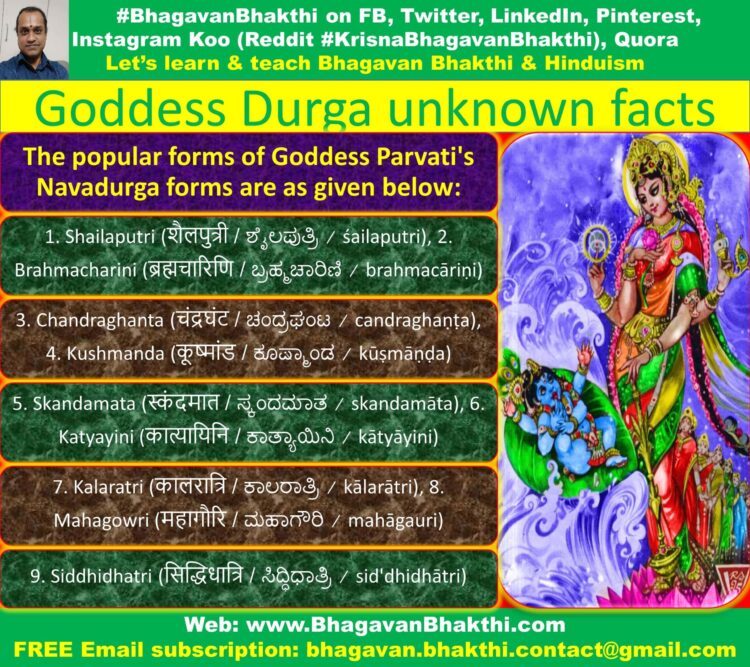
The popular forms of Goddess Parvati’s Navadurga forms are as given below:
1. Shailaputri (शैलपुत्री / ಶೈಲಪುತ್ರಿ / śailaputri)
2. Brahmacharini (ब्रह्मचारिणि / ಬ್ರಹ್ಮಚಾರಿಣಿ / brahmacāriṇi)
3. Chandraghanta (चंद्रघंट / ಚಂದ್ರಘಂಟ / candraghaṇṭa)
4. Kushmanda (कूष्मांड / ಕೂಷ್ಮಾಂಡ / kūṣmāṇḍa)
5. Skandamata (स्कंदमात / ಸ್ಕಂದಮಾತ / skandamāta)
6. Katyayini (कात्यायिनि / ಕಾತ್ಯಾಯಿನಿ / kātyāyini)
7. Kalaratri (कालरात्रि / ಕಾಲರಾತ್ರಿ / kālarātri)
8. Mahagowri (महागौरि / ಮಹಾಗೌರಿ / mahāgauri)
9. Siddhidhatri (सिद्धिधात्रि / ಸಿದ್ಧಿಧಾತ್ರಿ / sid’dhidhātri)
From the above, four out of Navadurga (Nine Durga) names, that is,
Shailaputri, Brahmacharini, Skandamata and Mahagowri are very clearly Goddess Parvati names.
It is very much understandable that Goddess Parvati is also Goddess Durga.
Who is real and supreme Goddess Durga
It is Sri Madhwacharya Ji who has given the ultimate explanation about Goddess Durga.
Sri Madhwacharya Ji quotes ‘Paingi shruti’ in Bruhadaranyaka Upanishad Bhashya listing out the various Goddess Lakshmi Roopas (forms) and avatars among which Goddess Durga is one.
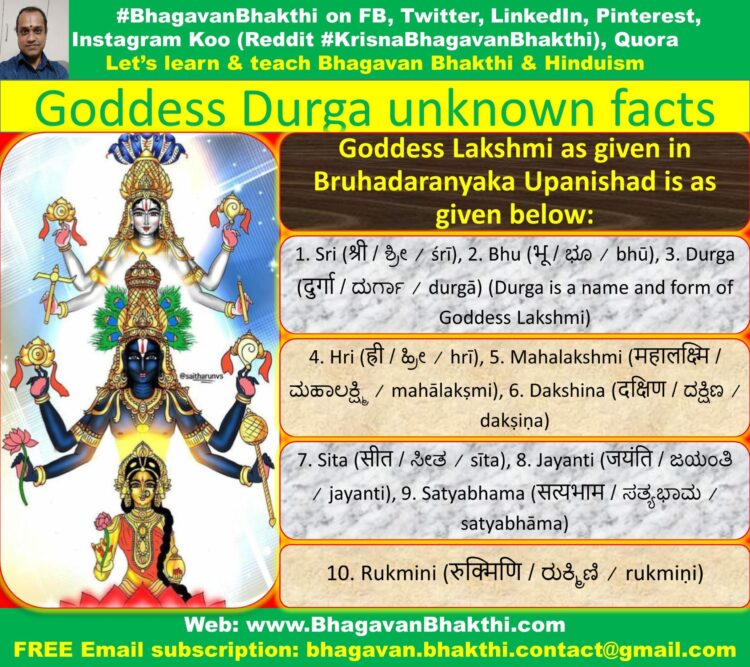
The complete list of Goddess Lakshmi as given in Bruhadaranyaka Upanishad is as given below:
1. Sri (श्री / ಶ್ರೀ / śrī) | 2. Bhu (भू / ಭೂ / bhū) | 3. Durga (दुर्गा / ದುರ್ಗಾ / durgā) (Durga is a name and form of Goddess Lakshmi) |
4. Hri (ह्री / ಹ್ರೀ / hrī) | 5. Mahalakshmi (महालक्ष्मि / ಮಹಾಲಕ್ಷ್ಮಿ / mahālakṣmi) | 6. Dakshina (दक्षिण / ದಕ್ಷಿಣ / dakṣiṇa) |
7. Sita (सीत / ಸೀತ / sīta) | 8. Jayanti (जयंति / ಜಯಂತಿ / jayanti) | 9. Satyabhama (सत्यभाम / ಸತ್ಯಭಾಮ / satyabhāma) | 10. Rukmini (रुक्मिणि / ರುಕ್ಮಿಣಿ / rukmiṇi)
Apart from these roopas (forms), Goddess Lakshmi takes unlimited forms including the consort of the Lord Vishnu’s avatars.
To know a long list of Goddess Lakshmi avatars, click the below link:
List of Goddess Lakshmi avatars
From the above explanation, it is very much clear that Goddess Durga is mainly a form of Goddess Lakshmi.
Second most supreme Goddess Durga is Goddess Saraswati and third most supreme Goddess Durga is Goddess Parvati.
This is the correct clarity as per Hindu scriptures.
Among the various roopas (forms) of Goddess Lakshmi, the trinamas (Three names), that is,
Sri, Bhu and Durga are the most important ones.
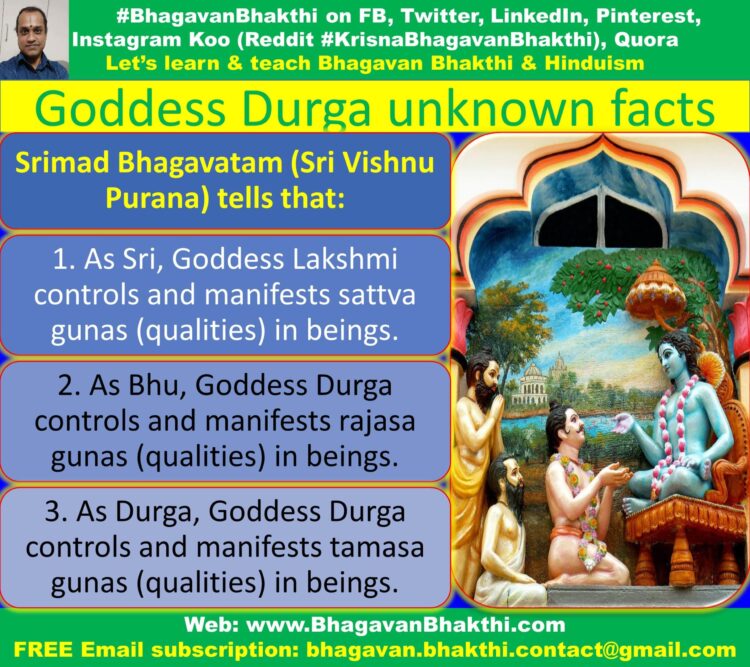
Srimad Bhagavatam (Sri Vishnu Purana) tells that:
1. As Sri, Goddess Lakshmi controls and manifests sattva gunas (qualities) in beings.
2. As Bhu, Goddess Durga controls and manifests rajasa gunas (qualities) in beings.
3. As Durga, Goddess Durga controls and manifests tamasa gunas (qualities) in beings.
Goddess Lakshmi makes beings (living beings) fall prey to aham (ego), selfishness causing sorrow and lose knowledge.
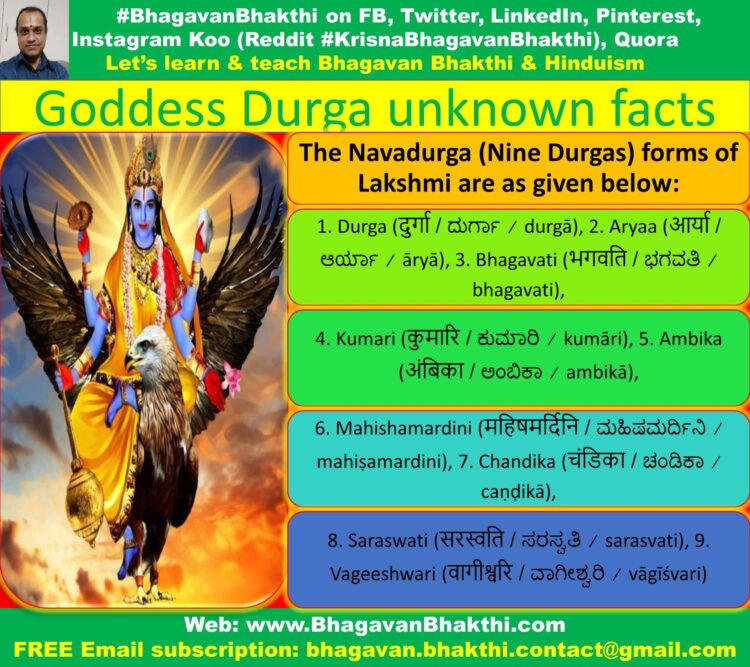
The Navadurga (Nine Durgas) forms of Lakshmi are as given below:
1. Durga (दुर्गा / ದುರ್ಗಾ / durgā) | 2. Aryaa (आर्या / ಆರ್ಯಾ / āryā) | 3. Bhagavati (भगवति / ಭಗವತಿ / bhagavati) |
4. Kumari (कुमारि / ಕುಮಾರಿ / kumāri) | 5. Ambika (अंबिका / ಅಂಬಿಕಾ / ambikā) | 6. Mahishamardini (महिषमर्दिनि / ಮಹಿಷಮರ್ದಿನಿ / mahiṣamardini) |
7. Chandika (चंडिका / ಚಂಡಿಕಾ / caṇḍikā) | 8. Saraswati (सरस्वति / ಸರಸ್ವತಿ / sarasvati) | 9. Vageeshwari (वागीश्वरि / ವಾಗೀಶ್ವರಿ / vāgīśvari) |
Real Hindu scriptures followers and real meaning seekers are supposed to worship these nine forms of Durga in Navaratri through antaryami upasana.
But the high expectations seekers or business minded mainstream media is so much forgotten the real values of Hindu scriptures,
that they just want to make money by forgetting the real values as per the Hindu scriptures.
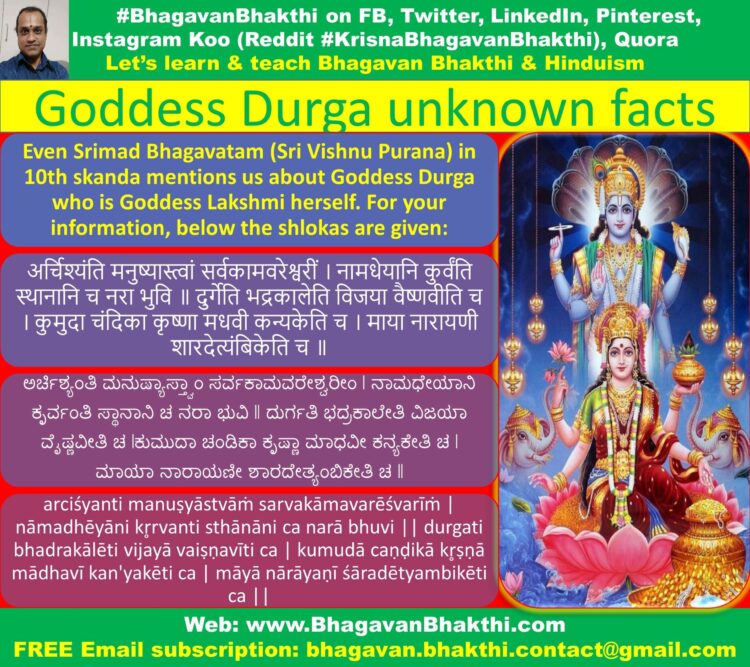
Even Srimad Bhagavatam (Sri Vishnu Purana) in 10th skanda mentions us about Goddess Durga who is Goddess Lakshmi herself. For your information, below the shlokas are given:
अर्चिश्यंति मनुष्यास्त्वां सर्वकामवरेश्वरीं । नामधेयानि कुर्वंति स्थानानि च नरा भुवि ॥
दुर्गेति भद्रकालेति विजया वैष्णवीति च । कुमुदा चंदिका कृष्णा मधवी कन्यकेति च । माया नारायणी शारदेत्यंबिकेति च ॥
ಅರ್ಚಿಶ್ಯಂತಿ ಮನುಷ್ಯಾಸ್ತ್ವಾಂ ಸರ್ವಕಾಮವರೇಶ್ವರೀಂ | ನಾಮಧೇಯಾನಿ ಕೃರ್ವಂತಿ ಸ್ಥಾನಾನಿ ಚ ನರಾ ಭುವಿ ||
ದುರ್ಗತಿ ಭದ್ರಕಾಲೇತಿ ವಿಜಯಾ ವೈಷ್ಣವೀತಿ ಚ | ಕುಮುದಾ ಚಂಡಿಕಾ ಕೃಷ್ಣಾ ಮಾಧವೀ ಕನ್ಯಕೇತಿ ಚ | ಮಾಯಾ ನಾರಾಯಣೀ ಶಾರದೇತ್ಯಂಬಿಕೇತಿ ಚ ||
arciśyanti manuṣyāstvāṁ sarvakāmavarēśvarīṁ | nāmadhēyāni kr̥rvanti sthānāni ca narā bhuvi ||
durgati bhadrakālēti vijayā vaiṣṇavīti ca | kumudā caṇḍikā kr̥ṣṇā mādhavī kan’yakēti ca | māyā nārāyaṇī śāradētyambikēti ca ||
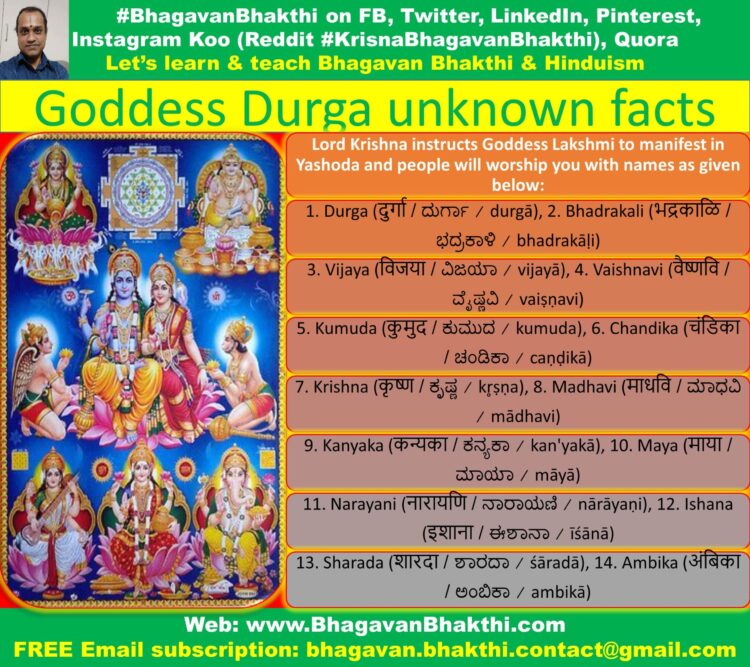
Lord Krishna instructs Goddess Lakshmi to manifest in Yashoda and people will worship you with names as given below:
1. Durga (दुर्गा / ದುರ್ಗಾ / durgā) | 2. Bhadrakali (भद्रकाळि / ಭದ್ರಕಾಳಿ / bhadrakāḷi) | 3. Vijaya (विजया / ವಿಜಯಾ / vijayā) |
4. Vaishnavi (वैष्णवि / ವೈಷ್ಣವಿ / vaiṣṇavi) | 5. Kumuda (कुमुद / ಕುಮುದ / kumuda) | 6. Chandika (चंडिका / ಚಂಡಿಕಾ / caṇḍikā) |
7. Krishna (कृष्ण / ಕೃಷ್ಣ / kr̥ṣṇa) | 8. Madhavi (माधवि / ಮಾಧವಿ / mādhavi) | 9. Kanyaka (कन्यका / ಕನ್ಯಕಾ / kan’yakā) |
10. Maya (माया / ಮಾಯಾ / māyā) | 11. Narayani (नारायणि / ನಾರಾಯಣಿ / nārāyaṇi) | 12. Ishana (इशाना / ಈಶಾನಾ / īśānā) |
13. Sharada (शारदा / ಶಾರದಾ / śāradā) | 14. Ambika (अंबिका / ಅಂಬಿಕಾ / ambikā)
More knowledge about Goddess Durga
1. ‘Prakasha Samhita’ (प्रकाश संहित / ಪ್ರಕಾಶ ಸಂಹಿತ / prakāśa sanhita)
Prakasha Samhita correlates the ‘Linga sharira’ of each of us to a coconut shell.
Just like a coconut shell has three holes at the top, but still binds the water, etc. inside it, the three roopas (forms) of Goddes Lakshmi, that is,
Sri, Bhu and Durga controls and binds us to the trigunas (Sattva, Rajasika and Tamasika).
2. How come Sri, Bhu and Durga forms and specially Durga in this context come into picture during Pralaya?
Again, Prakasha Samhita adds some knowledge about this. Prakasha Samhit says that,
Sri takes the form of water, Bhu takes the form of the leaf on which Lord Vishnu sleeps and Durga forms the darkness encompassing this.
3. Worship of Lord Vishnu and Goddess Lakshmi
Goddess Lakshmi and her forms wrongful upasana (Divine worship) is more widely spread among Devi (Shaktism) worshippers in Kali Yuga.
Foremost points have been sidelined, especially about Lord Vishnu.
Incorrect knowledge about Lord Vishnu and Goddess Lakshmi etc. is highly troublesome.
Goddess Lakshmi Devi is auspiciously ‘maha pativrata’ and she does not tolerate this.
Any Lord Vishnu’s worship, Durga Namaskaram, Chandika Homam etc. done without the real anusandhana (Divine knowledge) will not yield good results in the long run.
4. Agnana (ignorance) and Moha (soft spot)
Sri Madhwacharya Ji in his Gita tatparya says a devotee of Lord Vishnu has to cross the three gunas, that is,
Sattva Guna, Rajasika Guna and Tamasika Guna and their abhimanis (Controller deities), that is, Sri, Bhu and Durga to reach Goddess Mahalakshmi Devi.
Only with her grace, a devotee can easily reach Lord Vishnu.
For example, Agnana (ignorance) and moha (soft spot) are the biggest obstacles faced by sadhaka in this Kali Yuga.
Goddess Durga’s grace is absolutely essential to overcome these obstacles.
5. During Pralaya
During pralaya, Lord Narayana (Vishnu) sleeps alongside Goddess Lakshmi with her three forms, that is, Sri, Bhu and Durga.
Now, let us have more knowledge about Goddess Durga:
Durga meaning : Durga means, someone who kills all our durguna (Bad habits) from inside and outside of us.
Many have misconception that Sri Durga Devi is only the form of Sri Parvati Devi. It is not like that.
Tridevis (Saraswati, Lakshmi, Parvati) : Tridevi (Three Devis / Goddesses), that is Sri Mahalaksmi Devi, Sri Sarasvati Devi / Sri Bharati Devi and Sri Parvati Devi all are Sri Durga Devis.
Tridevi Durgas : All these three Devis take the Sri Durga Devi forms and come to earth to do their respective duties as per the instructions by Sri Mahavishnu / Sri Hari.
Different names of Durga : That’s why while doing stotram of Sri Durya Devi, usually different names are been used like:
Names of Durga : Sri Harini, Sri Narayini, Sri Varahi, Sri Narasimhini, Sri Rameshini, Sri Krishnahini, Sri Shivani, Sri Rudhrani, Sri Shankari, Sri Bhramini, etc.
Durga symbolism : Sri Durga Devi symbolizes the daivi shakti / divine forces (positive energy) that is used against the negative forces of rakshasas / demons.
Durga protection : Sri Durga Devi protects her devotees from rakshasa svabhava and safeguards them.
Durga combination : It is believed that Sri Durga Devi is the combined form of powers of Goddesses Lakshmi, Kali & Saraswati and also sometimes,
each Devi takes avatar in her own unique way, means sometimes as Mahalakshmi Devi or sometimes as Sarasvati Devi and sometimes as Parvati Devi.
Who created Durga : It is also a fact that Sri Durga Devi was created by Bhagavan Sri Vishnu as a warrior Devi to protect good people (devas) for fighting against the rakshasas like:
Mahishasura, Shumbha, Nishumbha, rakta beejaasura, etc etc etc.
Durga’s daivi shakti : Her daivi shakti contains the combined energies of Sri Bhagavan Vishnu and the Devatas / Demigods in the form of weapons and emblems (mudras).
Durga meaning in Sanskrit : The Sanskrit word Durga also (please see above) means fort or a place that is protected and thus difficult to reach.
Another meaning of Durga : Durga, also called Daivi Shakti, protects mankind from rakshasas and misery by destroying evil forces.
(Negative energy and vices—arrogance, jealousy, prejudice, hatred, anger, greed and selfishness).
Durga depiction : Sri Durga Devi is depicted as a warrior Devi with eight hands carrying weapons of different kinds assuming mudras, (symbolic hand gestures) that represent her teachings.
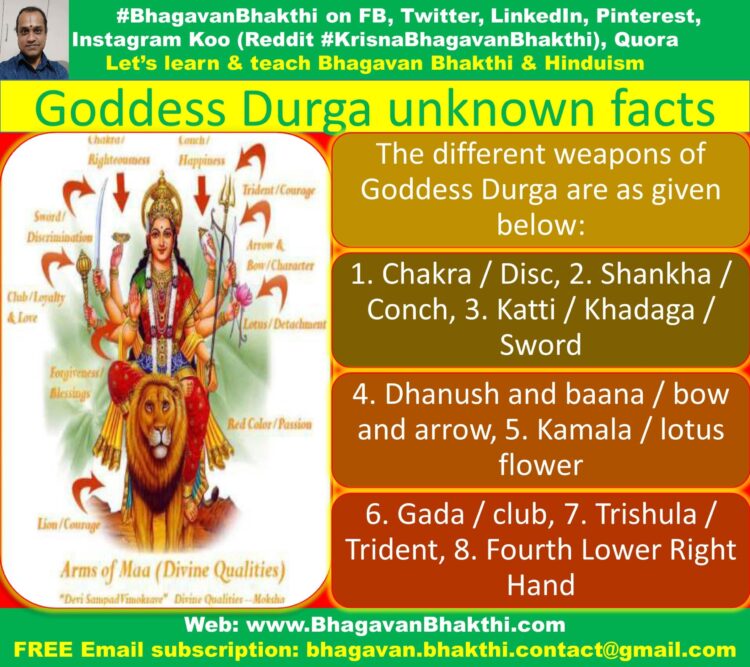
The different weapons of Goddess Durga are as given below:
1. Chakra – In her 1st upper right hand symbolizes dharma (duty/righteousness).
We must perform our duty/responsibilities in life.
2. Shankha / Conch – In her first upper left hand symbolizes happiness. We must perform our duty happily and cheerfully and not with resentment.
3. Katti / Khadga / Sword – In her second right lower hand symbolizes eradication of vices.
We must learn to discriminate and eradicate our evil qualities.
4. Dhanush and baana / bow and arrow – In her second left lower hand symbolizes character like Bhagavan Sri Rama.
When we face difficulties in our life we should not lose our character (values).
5. Kamala / lotus flower – In her third lower left hand symbolizes detachment.
We must live in the world without attachment to the external world.
Just like the kamala stays in dirty water yet smiles and gives its beauty to others.
This is the only way to receive Her blessings.
6. Gada / club – In her third right lower hand is the symbol of Hanuman and symbolizes devotion and surrender.
Whatever we do in our life we do with love and devotion and accept the outcome as the Bhagavan Sri Hari’s will.
7. Trishula / Trident – In her fourth left lower hand symbolizes courage.
We must have courage to eliminate our evil qualities and face the challenges in our life.
8. Fourth Lower Right Hand (Abhaya Mudra) – This symbolizes forgiveness and Her blessings.
We must forgive ourselves and others for mistakes and/or any hurt we may have caused.
Sri Durga Devi is depicted as riding on a lion or a tiger. A tiger symbolizes unlimited power.
Sri Durga Devi riding a tiger indicates that She possesses unlimited power and uses it to protect virtue and destroy evil.
The lion is a symbol of uncontrolled animalistic tendencies (such as anger, arrogance, selfishness, greed, jealousy, desire to harm others etc.)
and Her sitting on it reminds us to control these qualities, so that we are not controlled by them.
She is usually shown wearing a red saree.
The color red symbolizes action and the red clothes signify that She is destroying evil and protecting mankind from pain and suffering.
Thus, Sri Durga Devi symbolizes the Daivi shakti (positive energy) that is used against the negative forces of rakshasas.
She represents pure energy (positive), known as daiva jyoti / divine light that is the embodiment of feminine and creative energy.
Let us all bow down and pray to Sri Durga Devi to kill all our durguna and show the bhakthi to reach Sri Hari / Sri Krishna.
Now let us know 108 names of Goddess Durga Devi as given below:
Akashagamini – Flew In The Sky | Arogyada – Granter Of Good Health | Asurakshayamkari – Reducer Of The Number Of Demons |
Ataviduhkhandhara Rakshika – Protector From Ignorance And Distress | Ayurda – Granter Of Longevity | Balarkasadrushakara – Like The Rising Sun |
Bandhananashini – Detacher Of Attachments | Bhaktavatsala – Lover Of Devotees | Bhayanashini – Remover Of Fear |
Bhootanushruta – Well-Wisher Of Bhootaganas | Brahmacharini – Seeker Of Brahman | Chandravispardimukha – Beautiful Like The Moon |
Chaturbhuja – Four-Armed | Chaturvakttra – Four-Faced | Daya – Compassionate |
Devi – The Deity / Goddess | Dhanakshayanashini – Controller Of Wealth Decrease | Dhanurdharini – Holder Of Bow |
Dhruti – Valiant | Divamalya Vibhooshita – Adorned With Beautiful Garlands | Divyambaradhara – Beautifully Robed |
Durga – Deity Durga | Durga – Remover Of Distress | Durga – The Inaccessible |
Hri – Holy Chant Of Hymns | Indradhwaja Samabahudharini – With Shoulders Like Indra’s Flag | Jaya – Victorious |
Jyotsana – Radiant Like Flames | Kali – Dark-Complexioned | Kali – Goddess Of Death |
Kamacharini – Acting On One’s Own Accord | Kamsavidravanakari – Threatened Kamsa | Kantha – Radiant |
Kanttadhara – Holder of Shiva’s Neck | Kaumaravratadhara – Observer Of Fasts Like Young Girls Do | Keyurangadadharini – Bejewelled With Armlets And Bracelets |
Khadgaketaka Dharini – Holder Of Sword And Shield | Khama – Embodiment Of Forgiveness | Kirti – Famed |
Krishna – Dark-Complexioned | Krishna – Sister Of Krishna | Krishnachhavisama – Like Krishna’s Radiance |
Kulavardhini – Developer Of The Race | Kumari – Young Girl | Kundalapurnakarna Vibhooshita – Wearer Of Earrings Covering The Ears |
Mahachakradharini – Holder Of Chakra | Mahakali – Wife Of Mahakala | Mahishasuranashini – Destroyer Of Mahisha |
Mamsapriya – Fond Of Flesh | Mangalya – Auspicious | Mati – Wise |
Mayoora Pichhavalaya – Wearer Of Peacock-Feathered Bangles | Mohanashini – Destroyer Of Desires | Mruthyunashini – Destroyer Of Death |
Mukutavirajita – Shining With Crown Adorned | Nagararakshika – Protector Of Land | Nandagopakulajata – Daughter Of The Nandagopa Race |
Narayanavarapriya – Fond of Narayana’s Boons | Nitya – Eternal | Padmapatrakshi – Eyes Like The Lotus Leaf |
Pankajadharini – Lotus-Holder | Papadharini – Bearer Of Others’ Sins | Papaharini – Destroyer Of Sins |
Pashadharini – Holder Of Rope | Pashupriya – Fond Of All Beings | Patradharini – Vessel-Holder |
Peenashroni Payodhara – Large Bosomed | Prabha – Dawn | Prasanna – Cheerful |
Pravasarakshika – Protector Of Travellers | Purnachandra Nibhanana – Beautiful Like The Full Moon | Putrapamrityunashini – Sustainer Of Son’s Untimely Death |
Rajyada – Bestower Of Kingdom | Ratri – Night | Sagaragirirakshika – Protector Of Seas And Hills |
Sandhya – Twilight | Sangramajayaprada – Granter Of Victory In The War | Sangramarakshika – Protector Of Wars |
Sankarshanasamanana – Equal To Sankarshana | Santati – Granter Of Issues | Sarvakaryasiddhi Pradayika – Granter Of Success In All Attempts |
Saukhyada – Bestower Of Well-Being | Seedupriya – Fond Of Drinks | Sharanya – Granter Of Refuge |
Shatrusankata Rakshika – Protector From Distress Caused By Foes | Shikhipichhadwaja Virajita – Having Peacock-Feathered Flag | Shilathata Vinikshibda – At Birth, Slammed By Kamsa |
Shiva – Auspicious | Shiva – Shiva’s Half | Shree – Auspicious |
Siddhi – Successful | Surashreshtta – Supreme Among The Celestials | Sutada – Granter Of Issues |
Trailokyarakshini – Protector Of The Three Worlds | Tribhuvaneshwari – Goddess of The Three Worlds | Tridashapujita – The Goddess Of The Celestials |
Tridivabhavayirtri – Goddess Of The Three Worlds | Vapurda – Granter Of Beautiful Appearance | Varada – Bestower |
Varada – Granter Of Boons | Vasudevabhagini – Sister Of Vasudeva | Vidhya – Wisdom |
Vijaya – Conqueror | Vindhyavasini – Resident Of The Vindhyas | Vividayudhadhara – Bearer Of Various Weapons |
Vyadhinashini – Vanquisher Of Ailments | Yashodagarba – Sambhoota Emerging From Yashoda’s Womb |
More information will be added to his post (article) on regular basis. Please visit again to know the updated information after some time.
To watch videos on #Hinduism #Sanskrit language, SUBSCRIBE to my YouTube channel from this below link:
#BhagavanBhakthi YouTube channel
To know about “Goddess Durga Devi more information“, please click the below link:
Goddess Durga Devi more information
Dear friends, if you need any clarifications about this post, kindly let me know, I will definitely try to answer all of them.
Also your one LIKE, one COMMENT, One Share, one SUBSCRIPTION is highly important.
This will help to know the quality of this content and also it will be helpful to know if any improvements is required for the content.
If you feel this content is useful to you and has helped you to improve your knowledge, kindly share this with your well-wishers.
Because “SHARING MEANS CARING”.
For receive FREE EMAIL SUBSCRIPTION about #BhagavanBhakthi, you can send an email to bhagavan.bhakthi.contact@gmail.com from your email ID.
NAMASTE!
Sri Gurubhyo Namaha
Sri Krishnaaya Namaha
Sri Krishnaarpanamastu
Share in Social Media